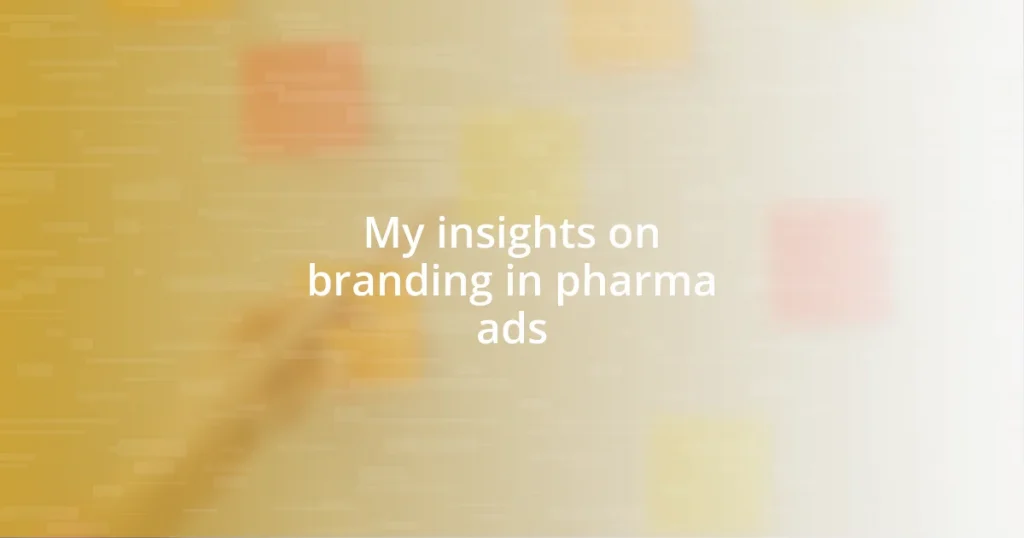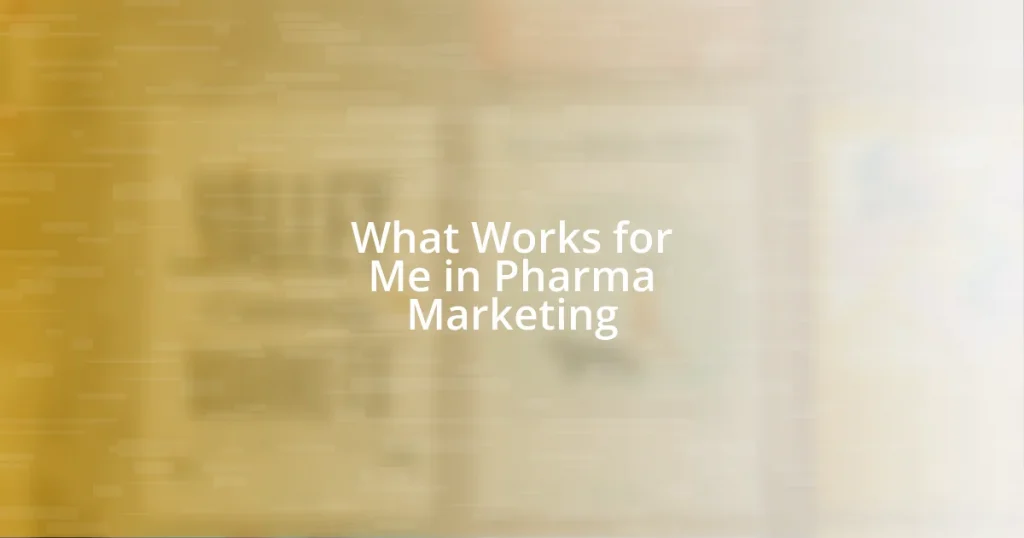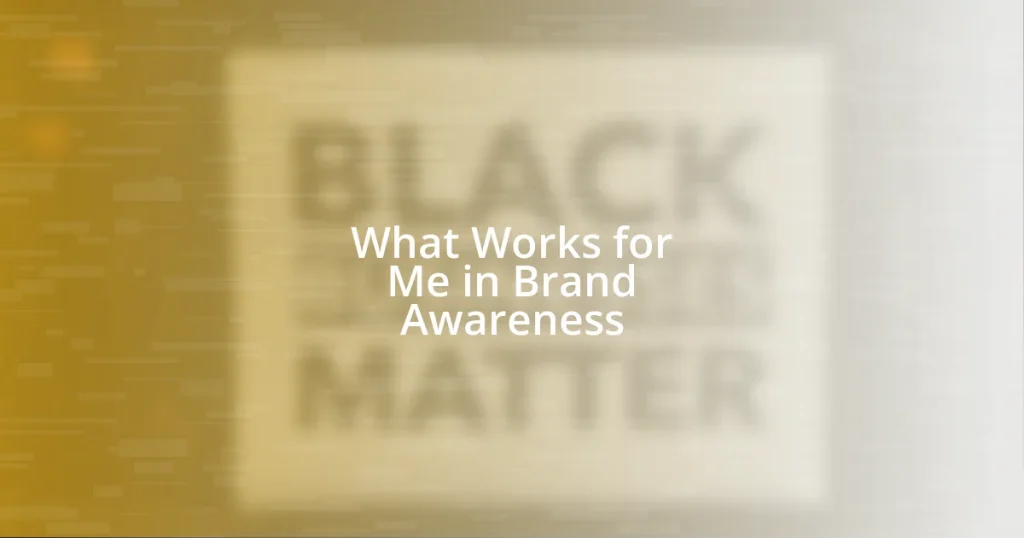Key takeaways:
- Emotional storytelling in pharma branding fosters trust and builds a sense of community among patients, making the brand feel like a partner in their health journey.
- Patient-centric messaging that incorporates transparency about potential side effects and personal experiences enhances brand loyalty and resonates deeply with audiences.
- The future of pharma advertising is shifting towards personalized, interactive content, emphasizing the importance of ethical messaging and transparency to engage younger consumers.

Understanding pharma branding strategies
Branding strategies in the pharmaceutical industry are unique because they often require balancing trust, transparency, and emotional connection. When I think back to a brand campaign I admired, it was one that beautifully illustrated how personal stories could resonate with patients facing chronic illnesses. Have you ever noticed how these ads often highlight real-life experiences? That emotional pull not only builds credibility but also fosters a sense of community among patients.
Another interesting facet is the importance of regulatory compliance. Pharma brands must navigate a landscape that is heavily regulated, which can feel stifling at times. However, I believe that creativity thrives under constraints. I’ve seen companies foster inventive branding by focusing more on educational content and patient empowerment. Isn’t it fascinating how information can sometimes be the best branding strategy?
Moreover, differentiation in such a saturated market is critical. I remember a campaign that used humor to address serious topics, breaking down barriers to engagement. This approach might seem unconventional, but it reminded me that effective branding can start conversations, making complex topics relatable. How can we embrace this idea of light-heartedness while still respecting the serious nature of health issues? It’s all about striking that delicate balance.

Importance of patient-centric messaging
When discussing the importance of patient-centric messaging, it becomes clear that understanding a patient’s journey is crucial. I recall a powerful ad that shared a patient’s struggle with a particular condition and how the medication helped them regain control of their life. That personal touch not only connected with me but also allowed me to see the brand as more than just a product—it felt like a partnership. This is the kind of resonance that patient-centric messaging can achieve.
Furthermore, patient-centric messages build trust through transparency. I’ve seen how ads that openly discuss potential side effects alongside the benefits resonate more with audiences. It’s refreshing to see brands that treat patients as informed participants in their own health decisions. By doing so, they foster a relationship built on honesty, which I find incredibly vital in today’s market.
Lastly, the emotional connection that emerges from patient-centric messaging cannot be overstated. I once encountered an ad that featured stories of hope and resilience, showing that patients are not alone in their battles. This approach not only humanizes the brand but also empowers patients, making them feel seen and understood.
| Traditional Messaging | Patient-Centric Messaging |
|---|---|
| Focuses on product features | Highlights patient experiences |
| Emphasizes clinical data | Shows emotional journeys |
| Generalized audience approach | Tailored for individual patient stories |

Utilizing emotional appeal in ads
I’ve always been fascinated by how emotional appeal in pharma ads can create a bridge between the product and the patient. A poignant moment for me was when I stumbled upon an ad that showcased a mother’s heartfelt journey caring for her child with a chronic illness. The raw emotion in her voice as she shared her fears and hopes struck a chord with me. It’s instances like these that reveal the true potential of emotional storytelling. These narratives not only evoke empathy but also reinforce a sense of solidarity among viewers.
- Emotional appeal can trigger powerful responses, making a memorable connection.
- It compels viewers to reflect on their personal experiences, often leading to a deeper brand affinity.
- Stories highlighting resilience and triumph often foster hope, positioning the brand as a source of support.
- Relatable characters in ads can break down barriers and humanize the brand, transforming it from a faceless entity into a companion on the health journey.
In my experience, emotional appeal in ads can also lead to increased brand loyalty. I recall a campaign featuring testimonies from patients who found renewed strength through a specific treatment. Hearing their struggles made the product feel less like a mere pharmaceutical option and more like a lifeline. This emotional resonance, I believe, converts viewers into advocates who not only trust the brand but feel personally invested in its mission.

Ensuring compliance with regulations
Ensuring compliance with regulations is an essential step in pharmaceutical advertising. I remember my initial days in the industry, when grappling with the FDA guidelines felt overwhelming. The prospect of non-compliance loomed large, as I often wondered, “How do we balance creativity with the stringent rules we must follow?” It became clear to me that every ad must navigate these waters carefully to maintain both integrity and trust with consumers.
Moreover, I’ve seen firsthand how a lack of adherence to regulatory standards can lead to significant consequences. For one campaign, we had to pull an ad merely because it overstated a product’s benefits. That experience taught me the value of meticulous review processes, where every claim must be backed by evidence. It’s remarkable how diligence can transform the message from potentially harmful to genuinely helpful.
Ultimately, compliance isn’t just about avoiding penalties; it shapes the entire branding strategy. I often reflect on how brands that view regulation as a partner rather than an adversary tend to create more impactful and responsible messaging. Isn’t it refreshing to know that a brand’s commitment to regulations can foster deeper trust with patients and healthcare providers alike? It’s a win-win situation that elevates the entire industry.

Analyzing successful pharma ad campaigns
Analyzing successful pharma ad campaigns often reveals recurring themes and strategies that resonate deeply with audiences. For instance, one campaign that struck me involved a series of short clips portraying real patients discussing their treatment journeys. It was captivating how these snippets showcased diverse perspectives, emphasizing that no one is alone in their health struggles. Seeing different demographics represented made it relatable and empowering—didn’t you feel a sense of community just watching it?
I think about how these campaigns often incorporate educational components, seamlessly blending valuable information with emotional narratives. I once encountered a campaign that did just that, explaining a complex condition while concurrently sharing personal stories of hope and recovery. It was powerful! This dual approach not only instills confidence in the product but also reinforces the brand’s commitment to patient education. I often ask myself, aren’t brands that prioritize transparency and education truly ahead of the game?
A particularly memorable campaign I analyzed featured a vibrant visual storytelling technique, using bright colors and uplifting music to convey a sense of hope. The choice of upbeat visuals juxtaposed with serious subjects caught me off guard at first, but it worked remarkably well to lighten the heaviness often associated with health issues. It made me realize that even in such a regulated industry, creativity can thrive without compromising the core message. How refreshing it is to think that innovative approaches can redefine norms in pharma advertising while touching lives!

Measuring the effectiveness of branding
Measuring the effectiveness of branding in pharma ads can be quite nuanced. From my experience, there’s no one-size-fits-all metric—what works for one brand may not resonate with another. I recall a campaign where we tracked brand recall through post-ad surveys, revealing that emotional storytelling led to higher recognition. The numbers didn’t just reflect awareness; they smiled back at us, proving that a heartfelt narrative could stick with our audience.
Another vital aspect I’ve observed is the importance of patient feedback. Engaging with patients directly often yields insights that quantitative data can overlook. For instance, I led a focus group session after a campaign launch, and listening to patients discuss how our messaging made them feel understood was enlightening. It reminded me that while analytics provide a baseline, emotions and sentiments can speak volumes. How could we ignore insights like that?
I’ve also found that conversion rates, when analyzed alongside engagement metrics, offer a more holistic view of branding success. One campaign aimed at increasing adherence to medication displayed a spike in patient enrollments after our ad aired. This made me ponder: Isn’t it fascinating that branding can have such a tangible impact on health behaviors? It’s this direct link between our strategies and actual patient outcomes that keeps me motivated in my work, blending creativity with purpose.

Future trends in pharma advertising
The future of pharma advertising is poised for significant transformation as digital platforms continue to dominate. I’ve seen how brands are increasingly leveraging artificial intelligence to tailor messages to specific audience segments. Imagine receiving an ad that understands your unique health journey! It’s exciting to think that personalization can reach new heights, creating deeper connections and fostering trust.
As we move forward, I can’t overlook the ethical implications of this evolution. I’ve noticed a growing demand for transparency, especially among younger consumers who value authenticity. It’s fascinating—how can brands balance enticing messaging with the responsibility of providing honest, straightforward information? I believe that companies that embrace this challenge will not only thrive but also cultivate a loyal patient base.
I also find the shift towards interactive content to be incredibly promising. For instance, I recently came across an app that allowed patients to visualize their treatment journey alongside interactive educational materials. It made me wonder, could this level of engagement redefine how we communicate complex medical information? I genuinely think this is the direction we’re heading—where education meets engagement, creating a more informed and empowered patient community.















